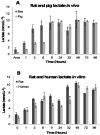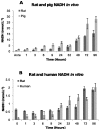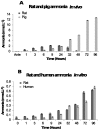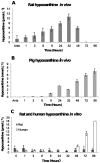Biochemistry changes that occur after death: potential markers for determining post-mortem interval
- PMID: 24278469
- PMCID: PMC3836773
- DOI: 10.1371/journal.pone.0082011
Biochemistry changes that occur after death: potential markers for determining post-mortem interval
Abstract
Death is likely to result in very extensive biochemical changes in all body tissues due to lack of circulating oxygen, altered enzymatic reactions, cellular degradation, and cessation of anabolic production of metabolites. These biochemical changes may provide chemical markers for helping to more accurately determine the time since death (post-mortem interval), which is challenging to establish with current observation-based methodologies. In this study blood pH and changes in concentration of six metabolites (lactic acid, hypoxanthine, uric acid, ammonia, NADH and formic acid) were examined post-mortem over a 96 hour period in blood taken from animal corpses (rat and pig) and blood from rats and humans stored in vitro. The pH and the concentration of all six metabolites changed post-mortem but the extent and rate of change varied. Blood pH in corpses fell from 7.4 to 5.1. Concentrations of hypoxanthine, ammonia, NADH and formic acid all increased with time and these metabolites may be potential markers for post-mortem interval. The concentration of lactate increased and then remained at an elevated level and changes in the concentration were different in the rat compared to the human and pig. This is the first systematic study of multiple metabolic changes post-mortem and demonstrates the nature and extent of the changes that occur, in addition to identifying potential markers for estimating post-mortem interval.
Conflict of interest statement
Figures







References
-
- Villas-Boas S, Roessner U, Hansen M, Smedsgaard J, Nielsen J (2007) Metabolome analysis : An introduction. New Jersey: John Wiley & Sons Inc.
-
- Jetter W (1959) Post-mortem Biochemical Changes. J Forensic Sci 4: 330-341.
-
- Marieb EN (1998) Human Anatomy and Physiology. California: Benjamin/Cummings Science Publishing.
-
- Cotran RS, Kumar V, Robbins SL (1994) Cellular injury and cellular death. In: Schoen FJ. Robbins Pathologic Basis of disease, 5th ed. Philadelphia: W.B. Saunders Company; pp. 4-11.
Publication types
MeSH terms
Substances
LinkOut - more resources
Full Text Sources
Other Literature Sources

